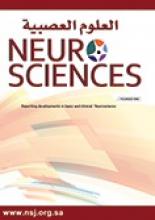Review ArticleReview Article
Open Access
Clinical and electrophysiological evaluation of carpal tunnel syndrome: approach and pitfalls
Mohammed H. Alanazy
Neurosciences Journal July 2017, 22 (3) 169-180; DOI: https://doi.org/10.17712/nsj.2017.3.20160638
Mohammed H. Alanazy
From the Division of Neurology, Department of Internal Medicine, King Saud University Medical City, King Saud University, Riyadh, Kingdom of Saudi Arabia
MD
References
- ↵
- Stevens JC
- ↵
- Gelfman R,
- Melton LJ,
- Yawn BP,
- Wollan PC,
- Amadio PC,
- Stevens JC
- ↵
- Atroshi I,
- Gummesson C,
- Johnsson R,
- Ornstein E,
- Ranstam J,
- Rosén I
- ↵
- Watson JC
- ↵
- Nora DB,
- Becker J,
- Ehlers JA,
- Gomes I
- ↵
- Stewart JD
- ↵
- Pham M,
- Bäumer P,
- Meinck H-M,
- Schiefer J,
- Weiler M,
- Bendszus M,
- et al.
- ↵
- Jablecki CK,
- Andary MT,
- Floeter MK,
- Miller RG,
- Quartly CA,
- Vennix MJ,
- et al.
- ↵
- Dorfman LJ,
- Robinson LR
- ↵
- Werner RA,
- Andary M
- ↵
- Chen S,
- Andary M,
- Buschbacher R,
- Del Toro D,
- Smith B,
- So Y,
- et al.
- ↵
- Nathan PA,
- Keniston RC,
- Myers LD,
- Meadows KD
- Werner RA,
- Franzblau A,
- Albers JW,
- Armstrong TJ
- ↵
- Werner RA,
- Jacobson JA,
- Jamadar DA
- ↵
- Preston D,
- Shapiro B
- Preston D,
- Shapiro B
- ↵
- Burnham RS,
- Burnham TR
- ↵
- Kumaraswamy L,
- Andary M,
- Bernaiche M,
- O'Connor R
- ↵
- Sandin KJ,
- Asch SM,
- Jablecki CK,
- Kilmer DD,
- Nuckols TK,
- Carpal Tunnel Quality Group
- ↵
- Robinson LR,
- Micklesen PJ,
- Wang L
- ↵
- Cifu DX,
- Saleem S
- ↵
- Uncini A,
- Di Muzio A,
- Awad J,
- Manente G,
- Tafuro M,
- Gambi D
- ↵
- Daube J,
- Stevens J
- ↵
- Preston D,
- Shapiro B
- Preston D,
- Shapiro B
- ↵
- Al-Shekhlee A,
- Fernandes Filho JA,
- Sukul D,
- Preston DC
- ↵
- Boonyapisit K,
- Katirji B,
- Shapiro BE,
- Preston DC
- ↵
- Meena AK,
- Srinivasa Rao B,
- Sailaja S,
- Mallikarjuna M,
- Borgohain R
- ↵
- Vogt T,
- Mika A,
- Thömke F,
- Hopf HC
- ↵
- Robinson LR,
- Micklesen PJ,
- Wang L
- ↵
- Roy J,
- Henry BM,
- PĘkala PA,
- Vikse J,
- Saganiak K,
- Walocha JA,
- et al.
- ↵
- Preston D,
- Shapiro B
- Preston D,
- Shapiro B
- ↵
- Ganes T
- ↵
- Gutmann L
- ↵
- Kim BJ,
- Date ES,
- Lee SH,
- Lau EW,
- Park MK
- ↵
- Robinson L
- ↵
- Sucher BM
- ↵
- Padua L,
- LoMonaco M,
- Gregori B,
- Valente EM,
- Padua R,
- Tonali P
- ↵
- Bland JD
- Brooks BR,
- Miller RG,
- Swash M,
- Munsat TL,
- World Federation of Neurology Research Group on Motor Neuron Diseases
- Levin KH
- Levin KH,
- Maggiano HJ,
- Wilbourn AJ
- Ferrante MA,
- Wilbourn AJ
- McGillicuddy JE
- Preston D,
- Shapiro B
- Preston D,
- Shapiro B
- Dumitru D,
- Amato AA,
- Zwarts MJ
- Amato A,
- Dumitru D
In this issue
Clinical and electrophysiological evaluation of carpal tunnel syndrome: approach and pitfalls
Mohammed H. Alanazy
Neurosciences Journal Jul 2017, 22 (3) 169-180; DOI: 10.17712/nsj.2017.3.20160638
Jump to section
Related Articles
- No related articles found.
Cited By...
- No citing articles found.





